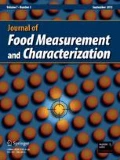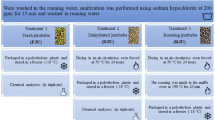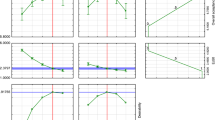Abstract
Monstera deliciosa fruit is an underutilized fruit found in Portugal. The present work aimed at studying the physicochemical, nutritional and sensorial characteristics of M. deliciosa fruit. Experimental production and characterization of distillates were also done, as well as the volatile profile comparison of the fruit, the fermented pulp and the obtained distillate. The results showed that M. deliciosa fruit harvested in Algarve (Portugal) has a very soft and white flesh, low pH (4.5) and high sugar:acid ratio (8.0). It has a mild acidity and astringency with a pleasant blend of consistency, sweetness, flavor and aroma, which may be due to the presence of volatiles, such as ethyl butanoate and linalool. Nutritionally, it has a high water (87.8%), followed by carbohydrates (9.4%), low protein (1.2%) and fat (0.6%) and considerable mineral contents (Ca, 83 mg/100 g; K, 190 mg/100 g; Na, 120 mg/100 g). M. deliciosa fruit has a total phenolic content of 327 mg/kg with an antioxidant activity of 348 µmol Trolox/100 g. One fruit per day provides 25% of the recommended daily intake of vitamin C (9 mg/100 g). Linalool, limonene and ethyl butanoate were found in the fruit, fermented pulp and distillate. The distillate volatile composition is similar to other fruit distillates and, among other important compounds, linalool, limonene and ethyl butanoate are partly responsible for its flavor and are present in concentrations of 6.7, 1.9 and 3.5 mg/100 mL, respectively. The fruit of M. deliciosa, harvested in Algarve showed good potential in being consumed fresh as well as its use for distillate production.



Similar content being viewed by others
References
V. Spínola, R. Perestrelo, J.S. Câmara, P.C. Castilho, Establishment of Monstera deliciosa fruit volatile metabolomic profile at diferente ripening stages using soli-phase microextraction combined with gas chromatography-mass spectrometry. Food Res. Int. 67, 409–417 (2015)
W.P. Gould, G.J. Hallman, Laboratory and field infestation studies on monster to determine its host status in relation to the Caribbean fruit fly (Diptera: Tephritidae). Fla. Entomol. 84(3), 437–438 (2001)
T.L. Peppard, Volatile flavor constituents of Monstera deliciosa. J. Agric. Food Chem. 40(2), 257–262 (1992)
A.L. Stahl, Composition of miscellaneous tropical and subtropical Florida fruits, Bulletin 283, University of Florida Agriculture Experiment Station (1935)
R.E. Peters, T.H. Lee, Composition and physiology of Monstera deliciosa fruit and juice. J. Food Sci. 42(4), 1132–1133 (1997)
L.A. Ramalho, R.H. Mascheroni, Quality evaluation of pineapple fruit drying process. Food Bioprod. Process. 90, 275–283 (2012)
O. Martinez, J. Salmerón, M.D. Guillén, C. Casas, Texture profile analysis of meat products treated with commercial liquid smoke flavourings. Food Control 15, 457–461 (2004)
AOAC, Official Method 964.24 and 936.16. pH, 16th edn. (AOAC, Gaithersburg, 1999)
AOAC, Official Method 942.15. Acidity/Titratable Acidity in Foods/Fruits and Fruit Products, 16th edn. (AOAC, Gaithersburg, 1999)
AOAC, Official method 932.12. Solids (Soluble) in Fruits and Fruit Products Refractometer Method, 16th edn. (AOAC, Gaithersburg, 1980)
NP 1420, Frutos, produtos hortícolas e seus derivados. Determinação dos açúcares totais, dos açúcares redutores e dos açúcares não redutores (sacarose). Técnica de Luff-Schoorl. Processo corrente (Instituto Português da Qualidade, Lisboa, 1987)
AOAC, Official method 934.01 Moisture in Animal Feed, 15th edn. (AOAC, Arlington, 1990)
AOAC, Official Method 920.152 Kjeldahl Method. Protein in Foods/Fruits and Fruit Products, 15th edn. (AOAC, Arlington, 1990)
AOAC, Official Method 948.22 Fat (Crude) in Nuts and Nut Products, 17th edn. (AOAC, Arlington, 2000)
AOAC, Official Method 940.26 Ash of Fruits and Fruits Products, 15th edn. (AOAC, Arlington, 1990)
European Commission, Directive 2008/100/EC of 28 October 2008 amending Council Directive 90/496/EEC on nutrition labelling for foodstuffs as regards recommended daily allowances, energy conversion factors and definitions, Annex II. Off. J. Eur. Union L285, 9–12 (2008)
B.W. Robinson, E. Stotz, The indophenol–xylene extraction method for ascorbic acid and modifications for interfering substances. J. Biol. Chem. 160, 217–225 (1945)
V. Raghu, K. Platel, K. Srinivasan, Comparison of ascorbic acid content of Emblica officinalis fruits determined by different analytical methods. J. Food Compos. Anal. 20, 529–533 (2007)
V.L. Singleton, R. Orthofer, R.M. Lamuela-Raventos, Analysis of total phenols and other oxidation substrates and antioxidants by means of Folin-Ciocalteau reagent. Methods Enzymol. 299, 152–178 (1999)
G. Boskou, F.N. Salta, C. Stavroula, A. Mylona, A. Chiou, K. Andrikopoulos, Antioxidant capacity and phenolic profile of table olives from the Greek market. Food Chem. 94, 558–564 (2006)
K. Thaipong, U. Boonprakob, K. Crosby, L. Cisneros-Zevallos, D.H. Byrne, Comparison of ABTS, DPPH, FRAP, and ORAC assays for estimating antioxidant activity from guava fruit extracts. J. Food Compos. Anal. 19, 669–675 (2006)
AOAC, Official Method 981.12. pH 15th edn. (AOAC, Washington, 1990)
AOAC, Official Method 945.08A. Ethanol, 15th edn. (AOAC, Washington, 1990)
AOAC, Official Method 945.08. Total Acidity, 15th edn. (AOAC, Washington 1990)
USDA, United States Department of Agriculture, Agriculture Research Service 2016, National Nutrient Database for Standard Reference Release 28. https://ndb.nal.usda.gov/ndb/foods. Accessed 12 May 2016
A. Salvador, T. Sanz, S.M. Fiszman, Changes in colour and texture and their relationship with eating quality during storage of two different dessert bananas. Postharvest Biol. Technol. 43, 319–325 (2007)
N. Bolivar-Fernandez, C. Saucedo-Veloz, S. Solis-Pereira, E. Sauri-Duch, Ripening of sugar apple fruits (Annona squamosa L.) developed in Yucatan, Mexico. Agrociencia-Mexico 43, 133–141 (2009)
K.N.V. Prasanna, D.V.S. Rao, S. Krishnamurthy, Effect of storage temperature on ripening and quality of custard apple (Annona squamosa L.) fruits. J. Hortic. Sci. Biotechnol. 75(5), 546–550 (2000)
W.B. Shen, C.R. Li, J.Y. Chen, J.H. Xie, W.J. Lu, Expansion gene expression in cherimoya fruit is correlated with flesh firmness during fruit ripening and softening. J. Hortic. Sci. Biotechnol. 84, 333–339 (2009)
A.P. Bartolomé, P. Rupérez, C. Fúster, Pineapple fruit: morphological characteristics, chemical composition and sensory analysis of Red Spanish and Smooth Cayenne cultivars. Food Chem. 53, 75–79 (1995)
I.A. Onimawo, Proximate composition and selected physicochemical properties of the seed, pulp and oil of sour sop (Annona muricata). Plant Foods Hum. Nutr. 57, 165–171 (2002)
V.R. Souza, P.A.P. Pereira, F. Queiroz, S.V. Borges, J.D.S. Carneiro, Determination of bioactive compounds, antioxidant activity and chemical composition of Cerrado Brazilian fruits. Food Chem. 134, 381–386 (2012)
V.M. Moo-Huchin, I. Estrada-Mota, R. Estrada-Léon, L. Cuevas-Glory, E. Ortiz-Vázquez, M.L.V. Vargas, D. Betancur-Ancona, E. Sauri-Duch, Determination of some physicochemical characteristics, bioactive compounds and antioxidant activity of tropical fruits from Yucutan, Mexico. Food Chem. 152, 508–515 (2014)
M. Isabelle, L.B. Lee, M.T. Lim, W.-P. Koh, D. Huang, C.N. Ong, Antioxidant activity and profiles of common fruits in Singapore. Food Chem. 123, 77–84 (2010)
E.H. Soufleros, S.A. Mygdalia, P. Natskoulis, Production process and characterization of the traditional Greek fruit distillate ‘‘Koumaro’’ by aromaticand mineral composition. J. Food Compos. Anal. 18, 699–716 (2005)
C. López-Vázquez, M.H. Bollaín, S. Moser, I. Orriols, Characterization and differentiation of monovarietal grape pomace distillate from native varieties of Galicia. J. Agric. Food Chem. 58, 9657–9665 (2010)
L.F. Hernández-Gómez, J. Ubeda-Iranzo, E. Garcia-Romero, A. Briones-Pérez, Comparative production of different melon distillates: chemical and sensory analyses. Food Chem. 90, 115–125 (2005)
C. López-Vázquez, L. García-Llobodanin, J.R. Pérez-Correa, F. López, P. Blanco, I. Orriols, Aromatic characterization of pot distilled kiwi spirits. J. Agric. Food Chem. 60, 2242–2247 (2012)
L. García-Llobodanin, M. Ferrando, C. Güel, F. López, Pear distillates: influence of the raw material used on final quality. Eur. Food Res. Technol. 228, 75–82 (2008)
S. Cortés, R. Rodríguez, J.S. Salgado, J.M. Domínguez, Comparative study between Italian and Spanish grape marc spirits in terms of major volatile compounds. Food Control 22, 673–680 (2011)
A.A. Apostolopoulou, A.I. Flouros, P.G. Demertzis, K. Akrida-Demertzi, Differences in concentration of principal volatile constituents in traditional Greek distillates. Food Control 16, 157–164 (2005)
E.E.C, Regulation, No 110/2008 of 15 January 2008. Offic. J Eur. Union L 39, 16–54 (2008)
E.H. Soufleros, A.S. Mygdalia, P. Natskoulis, Characterization and safety evaluation of the traditional Greek fruit distillate ‘‘Mouro’’ by flavor compounds and mineral analysis. Food Chem. 86, 625–636 (2004)
M.L. Silva, F.X. Malcata, G. De Revel, Volatile contents of grape marcs in Portugal. J. Food Compos. Anal. 9(1), 72–80 (1996)
M.L. Silva, F.X. Malcata, Relationships between storage conditions of grape pomace and volatile composition of spirits obtained therefrom. Am. J. Enol. Vitic. 49, 56–64 (1998)
C. Da Porto, D. Decorti, F. Tubaro, Evaluation of volatile compounds and antioxidant capacity of some commercial rums from Dominican Republic. Int. J. Food Sci. Technol. 46, 988–993 (2011)
Author information
Authors and Affiliations
Corresponding author
Rights and permissions
About this article
Cite this article
Barros, T., Galego, L. & Pires-Cabral, P. Monstera deliciosa fruit: physicochemical characterization and potential for distillate production. Food Measure 12, 2874–2882 (2018). https://doi.org/10.1007/s11694-018-9902-5
Received:
Accepted:
Published:
Issue Date:
DOI: https://doi.org/10.1007/s11694-018-9902-5




